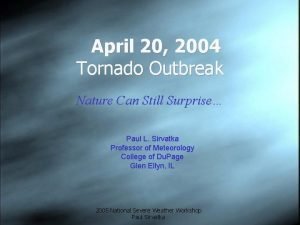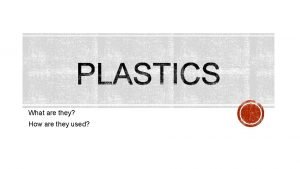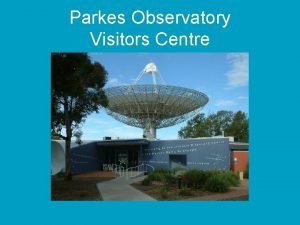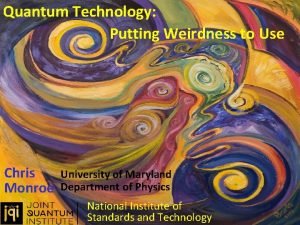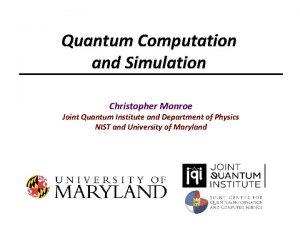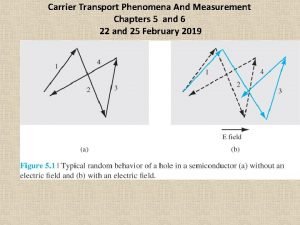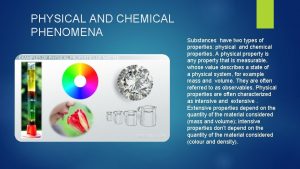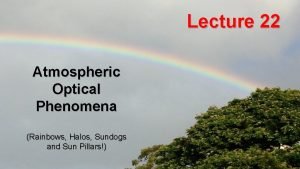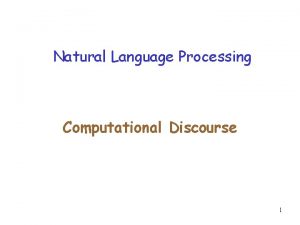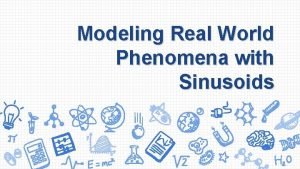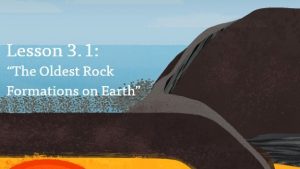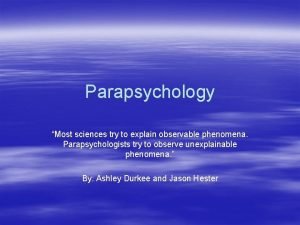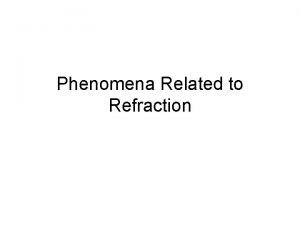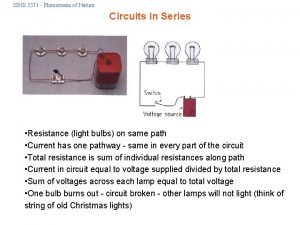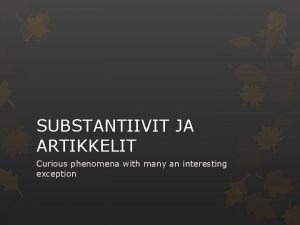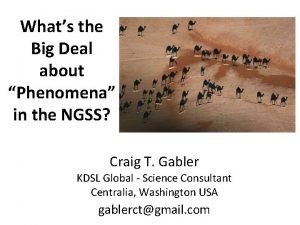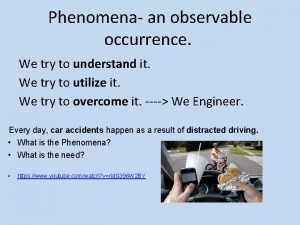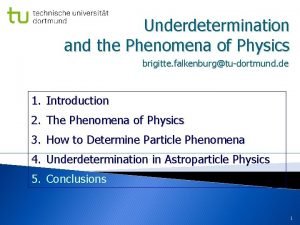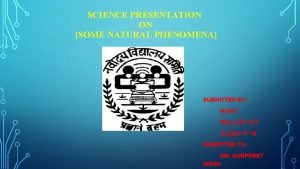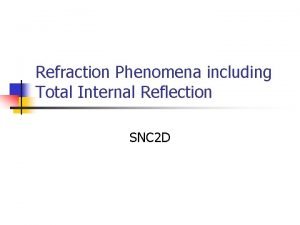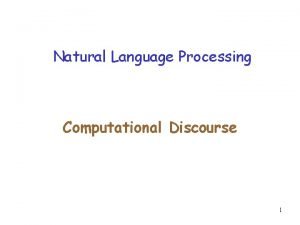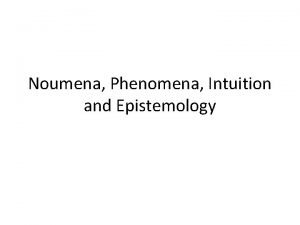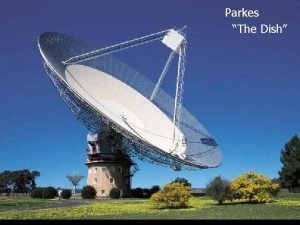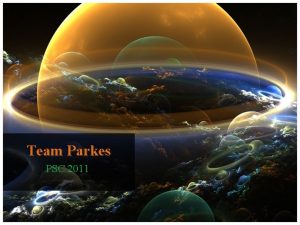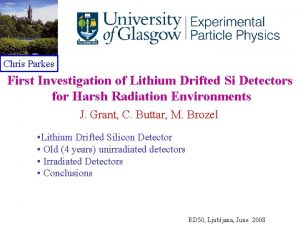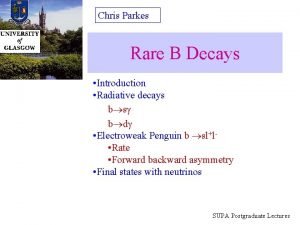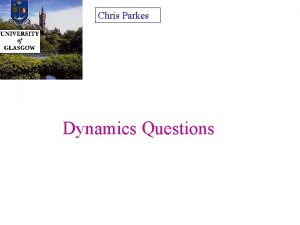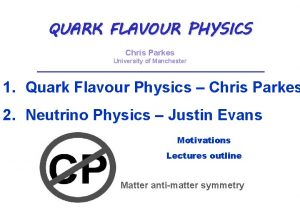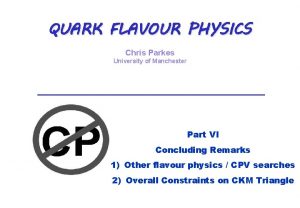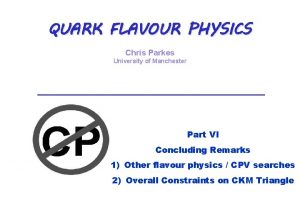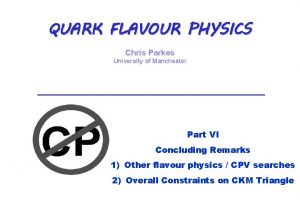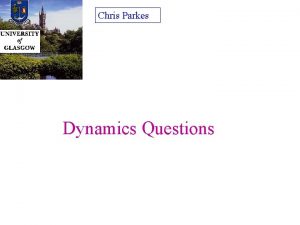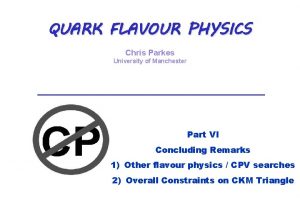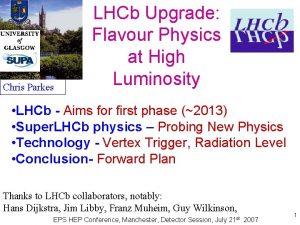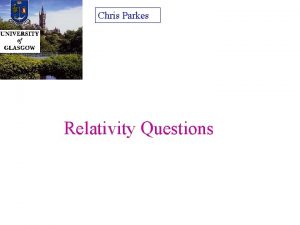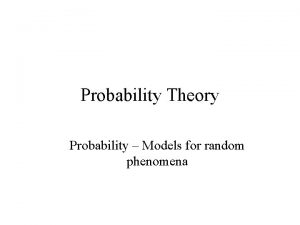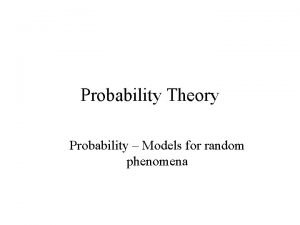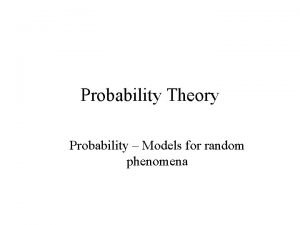Chris Parkes April 2004 Quantum Phenomena II Question












































- Slides: 44

Chris Parkes, April 2004 Quantum Phenomena II Question & Answer Session • • • Using the handsets A. Check handset is turned on -- green light on? B. Turn it over and read the 3 digit ID number C. Point at a receiver (small box with red light on) D. Press the number of your choice – see your ID come up on the screen – If your ID doesn't come up, wait a few seconds then try again. • Can change your vote, but don't keep sending unnecessarily as you will obstruct others' votes.

Is your handset working ? Yes

Graph: Is your handset working ?

How many magnetic substates (values of ml) does the electron d orbital have ? 1 2 3 4 5 6 7 8 9 0

Graph: How many magnetic substates (values of ml) does the electron d orbital have ?

States and their spectroscopic notation n l m 1 0 0 1 s 2 0 1 0 -1, 0, 1, 2 s 2 p 0 1 2 0 -1, 0, +1 -2, -1, 0, 1, 2 3 s 3 p 3 d 0 1 2 3 0 -1, 0, +1 -2, -1, 0, +1, +2 -3, -2, -1, 0, +1, +2 4 s 4 p 4 d 4 f 3 4

If electrons did not obey the Pauli exclusion Principle then. . The electrons in an atom would annihilate with the protons in the nucleus The electrons in an atom would all have the same energy The electrons would repel each other preventing the formation of atoms The electrons in an atom would have a continuous range of energies rather than lying in discrete levels

Graph: If electrons did not obey the Pauli exclusion Principle then. .

Pauli Exclusion Principle • No two electrons can occupy the same quantum mechanical state – Actually true for all fermions (1/2 integer spin) • Nothing to do with Electrostatic repulsion – Also true for neutrons • Deeply imbedded principle in QM • If all electrons were in the n=1 state all atoms would behave like hydrogen ground state – No chemistry – same properties

Black and white photographic film is more sensitive to blue than red light. Hence, there are. . . More photons in one joule of red light than in one joule of blue More photons in one joule of blue light than in one joule of red The same number of photons in one joule of red light as in one joule of blue

Graph: Black and white photographic film is more sensitive to blue than red light. Hence, there are. . .

Red/Blue • E=hf • Which light has higher frequency ? • That photon has more energy • Number of photons in 1 J = 1 J / Energy of 1 photon

Which is smaller ? An atom A light wave (visible spectrum) both are about the same

Graph: Which is smaller ?

Which is smaller? • Smooth reflecting surfaces – Atom must be smaller than wavelength of light • Sizes…. . • Bohr radius 52. 9 pm • Visible light 400 -700 nm • Electron microscope typically a few pm

We first learnt that the sun has a magnetic field By measurements made from spacecraft near the sun By the direct effect of the sun’s magnetic field on magnetic compasses on earth Because anything that has gravity must have magnetism The effect the sun’s magnetism has upon the light we get from the sun. We have no knowledge of the sun’s magnetic field and no present way to get any

Graph: We first learnt that the sun has a magnetic field

Zeeman Effect Nature, vol. 55 11 February 1897, pg. 347 • Observe energy spectrum of H atoms • Now …add magnetic field – Atoms have moving charges, hence magnetic interaction – Spectral lines split (Pieter Zeman, 1896) Discrete states as Ang. mom. quantized Angular momentum has made small contribution to energy (order 10, 000 th ) Fine Structure

If an electron was heavier spectral lines would be. . . shifted towards blue and closer together shifted towards red and closer together Shifted towards blue and further apart shifted towards red and further apart shifted towards blue and same distance apart shifted towards red and same distance apart closer together further apart unchanged

Graph: If an electron was heavier spectral lines would be. . .

H Energy levels Found an expression for E Ionised atom Energy levels depend upon Electron mass and n For transition n=4 n=3 n=2 Spacing depends upon n values and E 0 Photon Ef Emission E 0

When light emitted by a glowing gas is passed through a prism, a line spectrum is produced. A continuous spectrum will be produced if the gas is A mixture of several kinds of atoms Under low pressure Under high pressure None of these

Graph: When light emitted by a glowing gas is passed through a prism, a line spectrum is produced. A continuous spectrum will be produced if the gas is

Continuous Spectrum Each atom will have different set of atomic levels - electron orbits Different electron energy jumps Different photon energies Different line spectra More types of atoms, more lines Increase the pressure, atoms crowd each other Disturb each other’s atomic energy levels New orbits means new transition jumps More crowding , more energy jumps possible At high enough pressure have a continuous spectrum of energy transitions and hence of photon energies

An atomic bomb was exploded inside a box that was strong enough to contain all the energy released by the bomb. After the explosion the box would weigh More than before the explosion Less than before The same Nothing

Graph: An atomic bomb was exploded inside a box that was strong enough to contain all the energy released by the bomb. After the explosion the box would weigh

2 E=mc • Mass is turned into energy in explosion • So it weighs less ? • What is left of the bomb weighs less. • However, energy and mass are equivalent • So, considering the energy also the total weight is the same

The protons and neutrons in the atomic nucleus are held together by Gravity Electrostatic forces The weak nuclear force Magnetic forces The confining effect of the orbiting electrons None of the above

Graph: The protons and neutrons in the atomic nucleus are held together by

A quark is a A type of lepton A composite particle made from mesons and baryons A star that will become a black hole A galactical cluster A type of soft cheese

Graph: A quark is a

Quark • [Its also a name for the fundamental particles of which mesons and baryons (e. g. proton, neutr on) are made]

The age of the universe is roughly 15 thousand years times ten to the power ? 1 2 3 4 5 6 7 8 9 0

Graph: The age of the universe is roughly 15 thousand years times ten to the power ?

Which of these statements best describes your opinion of this session A waste of time Fun but not worthwhile, learnt less than in a lecture Would like a few questions like this put in one lecture per course Would like a few questions like this put in half of the lectures Would like a few questions like this in all lectures All lectures should be like this one

Graph: Which of these statements best describes your opinion of this session

QPII Tutorial Questions Tutorial in week 19 th – 23 rd April 1) From (updated) question sheet Question 1 & Question 4 2) In addition there is an on-line tutorial

Mastering Physics www. masteringphysics. com A web based physics tutorial system If you bought Young & Freedman 11 th edition you have free use of this system. If you don’t have free use then don’t pay as we are only doing this one on-line tutorial this year Go to website and register using the registration key that came with your book You will be asked for the course code this is: MPWARD 0005 You will have two assignments Introduction to using the system, Quantum Phenomena II

Quantum Phenomena II On-line tutorial • 3 Optional Introduction to the system practice questions • Learn to use the system • Try wrong answers • Try using hints • 3 Optional QP practice questions • Learn some physics! • 4 Assignment Questions • The system will give you a mark for these. • Only two tries allowed. • Bonus marks if you don’t use hints The assigned questions will probably take you around one hour. The questions are similar to those on the question sheet / in the book Not an exam – please use your books, notes if you wish as you would when doing normal tutorial question

Quantum Phenomena II On-line tutorial We are thinking of adopting this tutorial system for the new students in October so we would like to know your opinions. If you use it please could you provide feedback to c. parkes @ physics. gla. ac. uk h. ward @ physics. gla. ac. uk If you have any difficulties in accessing the system please can you also let us know. We will give a prize (book token) to the student who gets the best mark and provides the most useful feedback.

How useful do you find the use of handsets in your lecture? Not at all useful Not very useful extremely useful

balance of benefit vs. disadvantage from the use of the handsets in your lecture? Definite negative net value More disadvantage than benefit Neutral Benefits outweigh any disadvantages Definitely benefited

consider to be the most important benefit (if any) of the use of handsets in your lecture? Gives me an idea of how well everyone else is doing. Checks whether I am understanding the course material as well as I thought I was Allows me to answer privately without others knowing how I voted. Allows lecturers to identify problem areas Makes me think more about the course material during my lectures It's fun It makes the lectures more interactive Other benefit

consider to be the second most important benefit (if any) of the use of handsets in your lecture? Gives me an idea of how well everyone else is doing. Checks whether I am understanding the course material as well as I thought I was Allows me to answer privately without others knowing how I voted. Allows lecturers to identify problem areas Makes me think more about the course material during my lectures. It's fun It makes the lectures more interactive Other benefit
 Apod nasa gov calendar 1982
Apod nasa gov calendar 1982 Tornado outbreak of april 20, 2004
Tornado outbreak of april 20, 2004 How are they used?
How are they used? Dr miles parkes
Dr miles parkes Parkes observatory tours
Parkes observatory tours Dr peter parkes
Dr peter parkes Question
Question Classical mechanics
Classical mechanics Quantum physics vs mechanics
Quantum physics vs mechanics Chris monroe quantum
Chris monroe quantum Chris monroe ionq
Chris monroe ionq Carrier transport phenomena
Carrier transport phenomena Physical and chemical phenomena
Physical and chemical phenomena Optical phenomena rainbow
Optical phenomena rainbow Reoulox phenomena
Reoulox phenomena Reference phenomena in nlp
Reference phenomena in nlp Hypnotic phenomena
Hypnotic phenomena Real world phenomena
Real world phenomena Anchor phenomenon
Anchor phenomenon Observable phenomenon
Observable phenomenon Phenomena related to refraction
Phenomena related to refraction Noumena vs phenomena
Noumena vs phenomena Global climate phenomena
Global climate phenomena Surface phenomena and colloidal system
Surface phenomena and colloidal system Passer-by monikko
Passer-by monikko Noumena vs phenomena
Noumena vs phenomena Observable phenomena meaning
Observable phenomena meaning Contemporary phenomenon examples
Contemporary phenomenon examples Random phenomena
Random phenomena Brigitte falkenburg
Brigitte falkenburg Is gravity a natural phenomenon
Is gravity a natural phenomenon Natural phenomena introduction
Natural phenomena introduction Critical angle
Critical angle Surface and interfacial phenomena
Surface and interfacial phenomena Natural language processing
Natural language processing Noumenal
Noumenal Slidetodoc. com
Slidetodoc. com Compelling and supporting questions examples
Compelling and supporting questions examples Contoh open question
Contoh open question Example of compelling question
Example of compelling question General problem and specific problem example
General problem and specific problem example Present simple question words
Present simple question words Indirect answers to direct questions
Indirect answers to direct questions Clearinghouse probe
Clearinghouse probe 25 oktober 2004
25 oktober 2004

